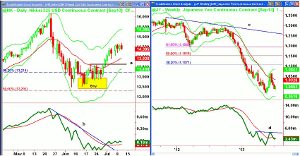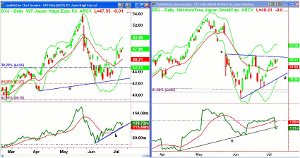With Abenomics hitting the shoals as global financial markets appear to lose confidence in the program, MoneyShow’s Tom Aspray takes a technical look to decipher what’s next for Japan’s stock market.
Stocks have had quite the post-July 4 celebration as they continued to move higher again on Tuesday. The market internals were strong again with advances leading declines by a 3-1 ratio. The A/D lines on the S&P 500, Nasdaq 100, and Russell 2000 have made new highs, which is consistent with a new uptrend.
Overall the Asian markets were positive overnight as the Shanghai Composite’s recouped its recent losses but Japan’s Nikkei 225 was down 0.40%. The sentiment on Japanese stocks has taken several wide swings in the past year.
Last November, many hedge funds were expressing their bearish outlook by buying up credit default swaps on Japan’s largest companies, but this was in contrast to the positive technical outlook. By early in 2013, the bullish sentiment had picked up, and by early May had reached bullish extremes.
The 22% drop in Nikkei from the May 23 high to the June 13 low caused many to sell their long positions in Japan’s stocks and to question their long-term outlook, as well the lasting benefit of a weaker yen.
The sharp correction took the Nikkei 225 back to good support, which I thought was the dip to buy. Now that the Nikkei 225 has rallied 16% from its lows, many who turned bearish last month are having second thoughts. So is the bottom in place or will June’s lows soon be broken?
Chart Analysis: The Nikkei 225 futures hit a high of 16,200 on May 22 before reversing the following day in reaction to the FOMC meeting, which spooked all the global markets.
- Just 11 days after the high, the futures hit a low of 12,490 before rebounding.
- The chart shows that this low was between the 38.2% and 50% Fibonacci retracement support levels.
- Typically, this is a high-probability entry level, and I identified 12,400-12,900 (yellow box) as a buying zone.
- The recent rally has taken the futures above the 50% retracement resistance with the 61.8% resistance at 14,818.
- The daily starc+ band is at 15,393.
- The OBV did form a negative divergence, line b, at the May highs but this downtrend has now been broken.
- The OBV is now above its WMA but has not yet started a clear new uptrend.
- On a short-term basis, a pullback looks likely with the rising 20-day EMA at 13,933 and further support at 13,600, line a.
The yen has had quite a drop since the fall of 2012 when the futures hit a high of 1.3356, then hit a low in May of 0.9654. This was a drop of 27% as the yen hugged the weekly starc- band for quite a few weeks in late 2012.
- The yen is close to its previous low and the severity of the recent drop makes a period of consolidation likely before the major downtrend resumes.
- There is first resistance at 1.0669 with the 38.2% Fibonacci retracement resistance at 1.1071.
- The weekly on-balance volume (OBV) has dropped back below its WMA and a move back above the resistance at line d would be a short-term positive.
- If the yen drops to new correction lows, a bullish divergence could be formed.
- There is next support at .9766 with the weekly starc- band at 0.9518.
NEXT PAGE: 2 Bottoming Japan-Focused ETFs
|pagebreak|The WisdomTree Japan Total Dividend Index (DXJ) hit a high of $53.95 in May, but just ten days later, traded as low as $42 in early June.
- DXJ then formed a trading range for the next 15 days as it retested the lows on June 14 when it made a low of $42.58.
- The surge in early July took DXJ above initial resistance as the daily starc+ band was tested.
- DXJ is holding above the quarterly pivot at $47.01 as the 50% retracement resistance at $47.99 was exceeded.
- A strong close above the 61.8% resistance at $49.40 would be a stronger sign that a bottom is in place.
- The OBV moved above its WMA on June 18 and now shows a clear uptrend, line b.
- The WMA is clearly rising, which is also a positive sign.
- There is initial support now at $46.21 and the rising 20-day EMA with further support at $44.80.
The WisdomTree Japan SmallCap Dividend (DFJ) peaked ahead of the Nikkei 225 on May 8 when it made a high of $53.01.
- The decline was more severe than that of DFJ as the 61.8% support at $44.80 was violated with the June 6 low of $44.07.
- So far, the rebound has stalled below the mid-June high at $48.79, line c.
- A strong close above this level would signal a rally to the 61.8% resistance at $49.59.
- The daily OBV shows a more erratic pattern as the average daily volume is much smaller at 100K than it is for DFJ.
- The uptrend, line e, has been slightly violated so the recent price range, lines c and d, could be a continuation pattern.
- There is first support at $47-$47.40 with the monthly pivot at $46.73.
- A drop below $45.28 would turn the focus back on the downside.
What it Means: It is my view that the decline in the yen from the 2012 highs has been enough to jump start the Japanese economy, which should have an impact into next year as it should boost exports. I think the action in the Nikkei 225 will be less dependent on the yen in the coming months. I think stocks like Toyota Motor Corp. (TM), which I recently recommended should do well.
The technical evidence indicates that the Nikkei 225 and WisdomTree Japan Total Dividend Index (DXJ) have bottomed.
The evidence for the WisdomTree Japan SmallCap Dividend (DFJ) is less conclusive as it still needs a further rally to complete its bottom formation.
For those who are not long, I will be watching for a pullback to determine new entry levels so follow my Twitter feed.
How to Profit: No new recommendation.
Portfolio Update: For the WisdomTree Japan Total Dividend Index (DXJ), should be 50% long at $44.54 and 50% long at $43.26. Use a stop now at $41.77. On a move above $49.40, raise the stop to $44.22.
For the WisdomTree Japan SmallCap Dividend (DFJ), should be 50% long at $45.66 and 50% long at $44.76. Use a stop now at $44.94. On a move above $48.81, raise the stop to $46.36.






















